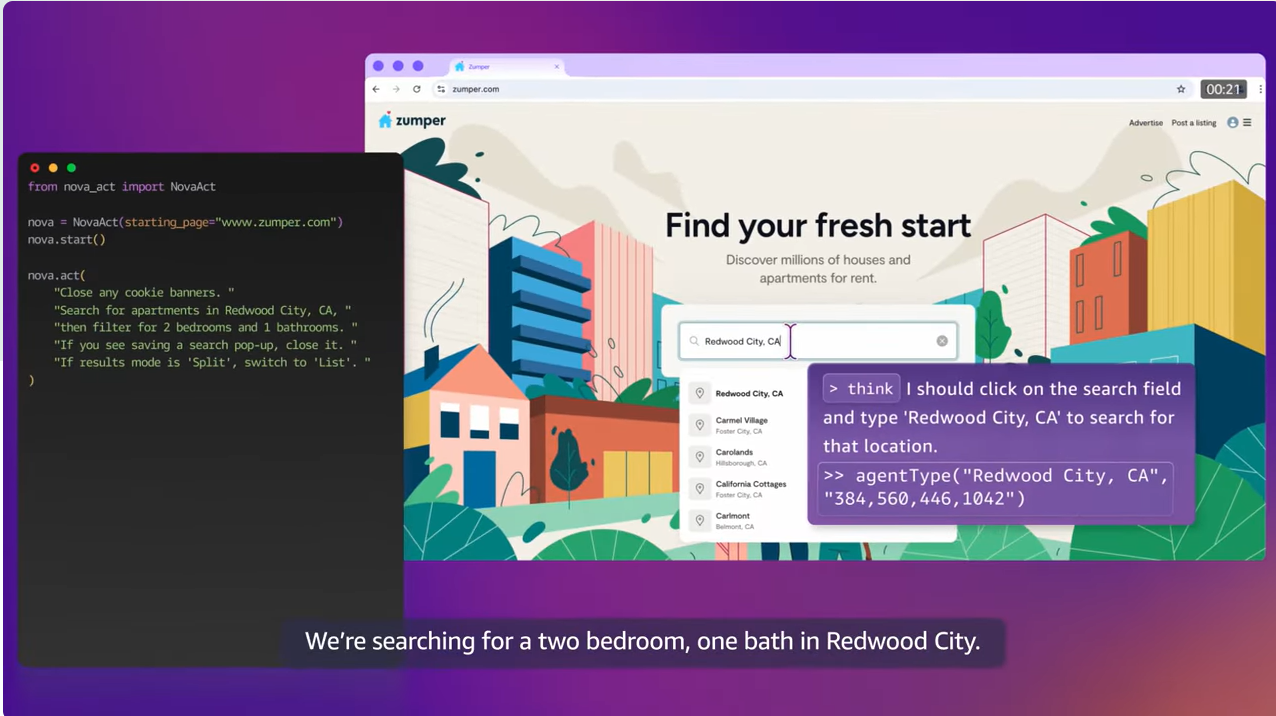Amazon Nova Act isn’t just another toy—it’s a bold move into the emerging world of agentic AI. It signals Amazon’s bet on what comes after chatbots: agents that do the work. At a time when most of the market is still figuring out prompt engineering, Amazon seems to have taken a massive step into the future of AI: models that don’t just respond, but also act.
True, Amazon Nova Act isn’t the only agent entry out there. But it’s already making a splash compared to earlier entries like OpenAI, Claude, and Google’s agent capabilities.
In Part 1 of this series, we saw how Nova earned its space at the GenAI table. Now, in Part 2, we’ll see how AWS is taking its AI play far beyond foundation models with Nova Act—a strategic expansion into the emerging field of autonomous AI agents.
What Is Amazon Nova Act?
Launched in early April 2025, Amazon Nova Act is AWS’s answer to Anthropic’s Claude agents (launched October 2024), Google Gemini agents (launched December 2024), and OpenAI’s Operator (launched January 2025).
Amazon Nova Act lets developers build browser-based, semi-autonomous AI agents that can perform real-world web tasks—think booking travel, filling forms, managing dashboards, or retrieving data from web interfaces.
Amazon Nova Act’s promises include:
- Run tasks securely inside a real browser without sharing sensitive data with the model.
- Mix Python with natural language for flexible, programmable workflows.
- Extract clean, structured data from even the messiest web pages.
- Extract clean, structured data from even the messiest web pages.
- Break complex jobs into tiny, precise steps for better automation control.
- Multitask across tabs or sites—acting as a “virtual assistant team.”
Amazon Nova Act provides a Python-based SDK that enables developers to create structured workflows where Nova models interact with web interfaces through a secure browser automation framework. The system includes components for task planning, web navigation, content extraction, and error recovery.
Where OpenAI’s approach leans toward end-to-end automation using a closed, high-trust assistant, this modular SDK gives Amazon Nova Act more transparency and control.
Developers can build agents step by step, monitor their execution in real time, and even plug in Python logic where needed. The trade-off is that it’s a bit more hands-on. But in exchange, you gain visibility and flexibility—both essential for enterprises that need to remain in control and compliant.
What makes Amazon Nova Act especially interesting is that it’s built natively into Bedrock, so agents can be triggered by cloud events (e.g., S3 updates, Lambda functions), work with secure identity layers (IAM), and run with enterprise compliance in mind.
Though it’s still in preview, Amazon Nova Act is already drawing attention from dev teams who have been experimenting with web scraping or RPA tools. They see it as a more scalable alternative that’s both competitively priced and already integrated with AWS offerings they’re already using.
No, Amazon wasn’t first to the table. But these two factors—reasonable price point and AWS integration—could well capture the lead for Amazon Nova Act as the most secure, reliable agent platform for enterprises that need to integrate AI with their existing AWS workloads.
Agents Are the Future—And AWS Knows It
IOD has been following the GenAI conversation closely from day one, from basic chatbot models to copilots—and now, to agents. This evolution mirrors how humans work: First we learn, then we assist, then we act.
Amazon Nova Act plays directly into this trend. But what makes AWS’s approach stand out isn’t just the timing—it’s the intentionality.
Right now, the main barriers to enterprise adoption of AI and agent technology are security and compliance. In addition, IT leaders are looking for solutions that integrate with their existing systems—without necessarily struggling to bring legacy systems up to speed.
So rather than rushing out a flashy demo, Amazon has released something sturdy, flexible, and enterprise-minded.
The SDK encourages responsible development. The browser agent is sandboxed. And while it’s capable of booking, buying, and navigating the web autonomously, AWS is careful to leave decision-making to the user—for now.
From what I’ve seen in early previews, Amazon Nova Act agents are fast, surprisingly accurate, and able to recover from failures with graceful fallback logic.
Based on internal AWS testing, Amazon Nova Act stands up nicely to other browser-based agent models (Claude 3.7 Sonnet and OpenAI’s CUA), which typically only deliver 30 to 60% task-completion accuracy. Amazon Nova Act achieved over 90% accuracy at tasks other agents failed, like date picking, dropdowns, and popups.
Amazon Nova Act led on the ScreenSpot Web Text benchmark (0.939) and on the Web Icon benchmark (0.879). However, on the more general GroundUI Web benchmark, Amazon Nova Act trailed slightly with a score of 0.805.
Amazon Nova Act is navigating the real web with real outputs. And that’s a game-changer for enterprise workflows that involve repetitive digital labor.
But it’s important to note that Amazon Nova Act is still in preview. It still faces real-world challenges that all agent systems encounter—especially when it comes to handling dynamic web interfaces and managing complex decision trees. Early adopters report a mix of impressive successes and occasional frustrating failures, which is typical for this emerging technology category.
- OpenAI’s Operator excels at end-to-end task completion with advanced reasoning but at higher cost.
- Anthropic’s Claude Agents offer industry-leading safety mechanisms and document processing capabilities but are more restrictive in autonomous actions.
- Google Gemini agents provide strong multimodal reasoning and app-building capabilities for non-developers but with more complex implementation requirements.
Amazon Nova Act trades some advanced reasoning capabilities for better enterprise controls and AWS integration.
A Few Words of Caution
As bullish as I am on Amazon Nova Act’s potential, it’s important to be clear: Agentic AI is still early territory.
Security, reliability, and governance will be major hurdles—especially when agents start transacting or handling sensitive data. AWS is being prudent, framing Amazon Nova Act as a toolkit, not a solution. That puts responsibility on developers and enterprise architects to build guardrails and human-in-the-loop mechanisms.
And then there’s the question of trust. Will businesses be ready to let AI agents execute on their behalf in production environments? How will legal and compliance teams vet the risks? These aren’t technical questions—they’re cultural ones.
But if anyone is positioned to address those concerns credibly, it’s AWS. With its track record in cloud security and its tightly integrated stack, it can offer agentic AI with the kind of safeguards that enterprises demand.
With the initial Amazon Nova Act release, security and safety features include:
- Guardrails that prevent it from handling password inputs or sensitive authentication data (PlayWright APIs are recommended for these instead)
- Detailed logging of agent actions
However, there are still potential areas for concern. For example, screenshots taken during execution will capture any visible sensitive information, such as credit card information. Further, the option to run in “headless” mode (with no visible browser window) diminishes the agent’s transparency.
In addition, many sites have increased their use of popups and captchas, designed to stymy browser-based agents (a few Amazon Nova Act users have published workarounds to get past these).
Overall, the browser-based nature of Amazon Nova Act offers both advantages and challenges. The transparency of watching the agent navigate web interfaces builds user trust and provides immediate visual feedback if something goes wrong. But browser interactions can be more fragile than API calls when websites change their interfaces.

Figure 1. High-level overview of API-based vs. GUI-based strategies for turning existing software into autonomous agents. Metrics shown: Accuracy—whether the agent completes the task as a human would; Ubiquity—how broadly applicable the agent is across task types; Efficiency—resource and time usage; Safety—potential for system harm; Invisible Tasks—agent’s ability to handle tasks beyond the visible interface; and Blackbox Software—can the agent operate without needing access to source code? (Adapted from ArXiv.)
Enterprise adopters should consider both the user experience benefits and the potential maintenance challenges when evaluating browser-based agent approaches versus API-driven alternatives.
A New Chapter in Enterprise AI?
Amazon Nova isn’t just about inference speed or benchmark bragging rights. With the launch of Amazon Nova Act, it’s clear that AWS has its sights set on something deeper: changing how work gets done.
While all major AI providers are developing agent capabilities, AWS is leveraging its enterprise cloud expertise to focus on secure, scalable integration with existing workloads—an approach that seems to resonate with its core customer base. However, early indications are that large enterprises are likely to use multiple agent platforms, depending on the use case, rather than stick with a single vendor.
Next up: In Part 3, we’ll dig into the competitive landscape and examine how AWS Nova stacks up against the heavyweights—OpenAI, Google Gemini, Anthropic Claude, and Microsoft Azure.
Spoiler: the ultimate winner may be determined by which platform best balances capability with usability.
Looking to optimize your AI workflows to scale your tech marketing? Contact us to learn more about IOD GenAI Labs.

